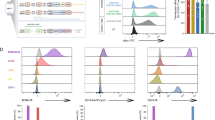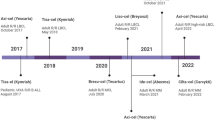Abstract
In chronic myeloid leukemia (CML), the translocation t(9;22) results in the fusion protein BCR-ABL (breakpoint cluster region-abelson murine leukemia), a tyrosine kinase mediating oncogenic signaling which is successfully targeted by treatment with BCR-ABL inhibitors like imatinib. However, BCR-ABL inhibitors may also affect antitumor immunity. For instance, it was reported that imatinib impairs the function of dendritic cells (DCs) that play a central role in initiating and sustaining T cell responses. Meanwhile, second generation BCR-ABL inhibitors like nilotinib, which inhibits BCR-ABL with enhanced potency have become standard of treatment, at least in patients with BCR-ABL kinase domain mutations. In this study we analyzed the influence of therapeutic concentrations of nilotinib on human monocyte-derived DCs and compared its effects to imatinib. We found that both tyrosine kinase inhibitors (TKI) comparably and significantly impaired differentiation of monocytes to DCs as revealed by curtated downregulation of CD14 and reduced upregulation of CD1a and CD83. This was only partially restored after withdrawal of the TKI. Moreover, both TKI significantly reduced activation-induced IL-12p70 and C-C motif chemokine ligand (CCL) 3 secretion, while divergent TKI effects for CCL2 and CCL5 were observed. In contrast, only nilotinib significantly impaired the migratory capacity of DCs and their capacity to induce T-cell immune responses in MLRs. Our results indicate that imatinib and nilotinib may differ significantly with regard to their influence on antitumor immunity. Thus, for future combinatory approaches and particularly stop studies in CML treatment, choice of the most suitable BCR-ABL inhibitor requires careful consideration.





Similar content being viewed by others
Abbreviations
- BB515:
-
Brilliant blue 515
- BCR-ABL:
-
Breakpoint cluster region-abelson murine leukemia
- CCL:
-
C-C motif chemokine ligand
- CCR:
-
C-C motif chemokine receptor
- CML:
-
Chronic myeloid leukemia
- DC:
-
Dendritic cell
- DMFI:
-
Delta MFI
- FSC:
-
Forward scatter
- GITR/GITRL:
-
Glucocorticoid-induced tumor necrosis factor receptor/-ligand
- HLA-DR:
-
Human leukocyte antigen–antigen D related
- MIP-3β:
-
Macrophage-inflammatory protein 3β
- RANK:
-
Receptor activator of NF-κB
- RANKL:
-
Receptor activator of NF-κB ligand
- SSC:
-
Side scatter
- TKI:
-
Tyrosine kinase inhibitor
References
Lechner CJ, Grünebach F, Brossart P et al. (2009) Effects of BCR/ABL inhibitors on monocyte-derived dendritic cells. Onkologie 32(suppl 4):1–80. https://doi.org/10.1159/000242462 (poster)
Schmidt SM, Lechner CJ, Gruenebach F et al (2009) BCR/ABL Inhibitors influence phenotype and function of monocyte-derived human dendritic cells. Blood 114:22 1116 [poster].
Druker BJ, Talpaz M, Resta DJ et al (2001) Efficacy and safety of a specific inhibitor of the BCR-ABL tyrosine kinase in chronic myeloid leukemia. N Engl J Med 344:1031–1037. https://doi.org/10.1056/NEJM200104053441401
O’Brien SG, Guilhot F, Larson RA et al (2003) Imatinib compared with interferon and low-dose cytarabine for newly diagnosed chronic-phase chronic myeloid leukemia. N Engl J Med 348:994–1004. https://doi.org/10.1056/NEJMoa022457
Hughes TP, Kaeda J, Branford S et al (2003) Frequency of major molecular responses to imatinib or interferon alfa plus cytarabine in newly diagnosed chronic myeloid leukemia. N Engl J Med 349:1423–1432. https://doi.org/10.1056/NEJMoa030513
Druker BJ, Guilhot F, O’Brien SG et al (2006) Five-year follow-up of patients receiving imatinib for chronic myeloid leukemia. N Engl J Med 355:2408–2417. https://doi.org/10.1056/NEJMoa062867
Gorre ME, Mohammed M, Ellwood K et al. (2001) Clinical resistance to STI-571 cancer therapy caused by BCR-ABL gene mutation or amplification. Science. 293:876–880. https://doi.org/10.1126/science.1062538
Shah NP, Nicoll JM, Nagar B et al. (2002) Multiple BCR-ABL kinase domain mutations confer polyclonal resistance to the tyrosine kinase inhibitor imatinib (STI571) in chronic phase and blast crisis chronic myeloid leukemia. Cancer Cell 2:117–125
Talpaz M, Shah NP, Kantarjian H et al (2006) Dasatinib in imatinib-resistant Philadelphia chromosome-positive leukemias. N Engl J Med 354:2531–2541. https://doi.org/10.1056/NEJMoa055229
Kantarjian H, Giles F, Wunderle L et al (2006) Nilotinib in imatinib-resistant CML and Philadelphia chromosome-positive ALL. N Engl J Med 354:2542–2551. https://doi.org/10.1056/NEJMoa055104
Kantarjian H, Shah NP, Hochhaus A et al (2010) Dasatinib versus imatinib in newly diagnosed chronic-phase chronic myeloid leukemia. N Engl J Med 362:2260–2270. https://doi.org/10.1056/NEJMoa1002315
Saglio G, Kim DW, Issaragrisil S et al (2010) Nilotinib versus imatinib for newly diagnosed chronic myeloid leukemia. N Engl J Med 362:2251–2259. https://doi.org/10.1056/NEJMoa0912614
Rix U, Hantschel O, Durnberger G et al (2007) Chemical proteomic profiles of the BCR-ABL inhibitors imatinib, nilotinib, and dasatinib reveal novel kinase and nonkinase targets. Blood 110:4055–4063. https://doi.org/10.1182/blood-2007-07-102061
Weisberg E, Manley PW, Breitenstein W et al. (2005) Characterization of AMN107, a selective inhibitor of native and mutant Bcr-Abl. Cancer Cell 7:129–141. https://doi.org/10.1016/j.ccr.2005.01.007
Lombardo LJ, Lee FY, Chen P et al (2004) Discovery of N-(2-chloro-6-methyl- phenyl)-2-(6-(4-(2-hydroxyethyl)- piperazin-1-yl)-2-methylpyrimidin-4- ylamino)thiazole-5-carboxamide (BMS-354825), a dual Src/Abl kinase inhibitor with potent antitumor activity in preclinical assays. J Med Chem 47:6658–6661. https://doi.org/10.1021/jm049486a
Krusch M, Salih HR (2011) Effects of BCR-ABL inhibitors on anti-tumor immunity. Curr Med Chem 18:5174–5184
Banchereau J, Steinman RM (1998) Dendritic cells and the control of immunity. Nature. 392:245–252. https://doi.org/10.1038/32588
Banchereau J, Briere F, Caux C et al (2000) Immunobiology of dendritic cells. Annu Rev Immunol 18:767–811. https://doi.org/10.1146/annurev.immunol.18.1.767
Cella M, Sallusto F, Lanzavecchia A (1997) Origin, maturation and antigen presenting function of dendritic cells. Curr Opin Immunol 9:10–16
Appel S, Boehmler AM, Grunebach F et al. (2004) Imatinib mesylate affects the development and function of dendritic cells generated from CD34+ peripheral blood progenitor cells. Blood 103:538–544. https://doi.org/10.1182/blood-2003-03-0975
Appel S, Rupf A, Weck MM et al (2005) Effects of imatinib on monocyte-derived dendritic cells are mediated by inhibition of nuclear factor-kappaB and Akt signaling pathways. Clin Cancer Res 11:1928–1940. https://doi.org/10.1158/1078-0432.CCR-04-1713
Wang H, Cheng F, Cuenca A et al (2005) Imatinib mesylate (STI-571) enhances antigen-presenting cell function and overcomes tumor-induced CD4+ T-cell tolerance. Blood 105:1135–1143. https://doi.org/10.1182/blood-2004-01-0027
Brossart P, Grunebach F, Stuhler G et al (1998) Generation of functional human dendritic cells from adherent peripheral blood monocytes by CD40 ligation in the absence of granulocyte-macrophage colony-stimulating factor. Blood 92:4238–4247
Brossart P, Schneider A, Dill P et al (2001) The epithelial tumor antigen MUC1 is expressed in hematological malignancies and is recognized by MUC1-specific cytotoxic T-lymphocytes. Cancer Res 61:6846–6850
Salih J, Hilpert J, Placke T et al (2010) The BCR/ABL-inhibitors imatinib, nilotinib and dasatinib differentially affect NK cell reactivity. Int J Cancer 127:2119–2128. https://doi.org/10.1002/ijc.25233
Schwarzbich MA, Gutknecht M, Salih J et al (2012) The immune inhibitory receptor osteoactivin is upregulated in monocyte-derived dendritic cells by BCR-ABL tyrosine kinase inhibitors. Cancer Immunol Immunother 61:193–202. https://doi.org/10.1007/s00262-011-1096-1
Etienne G, Guilhot J, Rea D et al (2017) Long-term follow-up of the French Stop Imatinib (STIM1) study in patients with chronic myeloid leukemia. J Clin Oncol 35:298–305. https://doi.org/10.1200/JCO.2016.68.2914
Mahon FX, Rea D, Guilhot J et al (2010) Discontinuation of imatinib in patients with chronic myeloid leukaemia who have maintained complete molecular remission for at least 2 years: the prospective, multicentre Stop Imatinib (STIM) trial. Lancet Oncol 11:1029–1035. https://doi.org/10.1016/S1470-2045(10)70233-3
Ross DM, Branford S, Seymour JF et al (2010) Patients with chronic myeloid leukemia who maintain a complete molecular response after stopping imatinib treatment have evidence of persistent leukemia by DNA PCR. Leukemia 24:1719–1724. https://doi.org/10.1038/leu.2010.185
Chomel JC, Bonnet ML, Sorel N et al (2011) Leukemic stem cell persistence in chronic myeloid leukemia patients with sustained undetectable molecular residual disease. Blood 118:3657–3660. https://doi.org/10.1182/blood-2011-02-335497
Ross DM, Branford S, Seymour JF et al. (2013) Safety and efficacy of imatinib cessation for CML patients with stable undetectable minimal residual disease: results from the TWISTER study. Blood 122:515–522. https://doi.org/10.1182/blood-2013-02-483750
Rea D, Nicolini FE, Tulliez M et al. (2017) Discontinuation of dasatinib or nilotinib in chronic myeloid leukemia: interim analysis of the STOP 2G-TKI study. Blood 129:846–854. https://doi.org/10.1182/blood-2016-09-742205
Hsu FJ, Benike C, Fagnoni F et al. (1996) Vaccination of patients with B-cell lymphoma using autologous antigen-pulsed dendritic cells. Nat Med 2:52–58
Small EJ, Fratesi P, Reese DM et al. (2000) Immunotherapy of hormone-refractory prostate cancer with antigen-loaded dendritic cells. J Clin Oncol 18:3894–3903. https://doi.org/10.1200/JCO.2000.18.23.3894
Small EJ, Schellhammer PF, Higano CS et al (2006) Placebo-controlled phase III trial of immunologic therapy with sipuleucel-T (APC8015) in patients with metastatic, asymptomatic hormone refractory prostate cancer. J Clin Oncol 24:3089–3094. https://doi.org/10.1200/JCO.2005.04.5252
Higano CS, Schellhammer PF, Small EJ et al (2009) Integrated data from 2 randomized, double-blind, placebo-controlled, phase 3 trials of active cellular immunotherapy with sipuleucel-T in advanced prostate cancer. Cancer 115:3670–3679. https://doi.org/10.1002/cncr.24429
Kantoff PW, Higano CS, Shore ND et al. (2010) Sipuleucel-T immunotherapy for castration-resistant prostate cancer. N Engl J Med 363:411–422. https://doi.org/10.1056/NEJMoa1001294
Held SA, Duchardt KM, Tenzer S et al. (2013) Imatinib mesylate and nilotinib affect MHC-class I presentation by modulating the proteasomal processing of antigenic peptides. Cancer Immunol Immunother 62:715–726. https://doi.org/10.1007/s00262-012-1373-7
Schade AE, Schieven GL, Townsend R et al (2008) Dasatinib, a small-molecule protein tyrosine kinase inhibitor, inhibits T-cell activation and proliferation. Blood 111:1366–1377. https://doi.org/10.1182/blood-2007-04-084814
Weichsel R, Dix C, Wooldridge L et al (2008) Profound inhibition of antigen-specific T-cell effector functions by dasatinib. Clin Cancer Res 14:2484–2491. https://doi.org/10.1158/1078-0432.CCR-07-4393
Fraser CK, Blake SJ, Diener KR et al. (2009) Dasatinib inhibits recombinant viral antigen-specific murine CD4+ and CD8+ T-cell responses and NK-cell cytolytic activity in vitro and in vivo. Exp Hematol 37:256–265. https://doi.org/10.1016/j.exphem.2008.09.013
Fei F, Yu Y, Schmitt A et al. (2008) Dasatinib exerts an immunosuppressive effect on CD8+ T cells specific for viral and leukemia antigens. Exp Hematol 36:1297–1308. https://doi.org/10.1016/j.exphem.2008.05.002
Curtsinger JM, Mescher MF (2010) Inflammatory cytokines as a third signal for T cell activation. Curr Opin Immunol 22:333–340. https://doi.org/10.1016/j.coi.2010.02.013
Boissel N, Rousselot P, Raffoux E et al. (2006) Imatinib mesylate minimally affects bcr-abl + and normal monocyte-derived dendritic cells but strongly inhibits T cell expansion despite reciprocal dendritic cell-T cell activation. J Leukoc Biol. 79:747–756. https://doi.org/10.1189/jlb.0705419
Hadzijusufovic E, Albrecht-Schgoer K, Huber K et al (2017) Nilotinib-induced vasculopathy: identification of vascular endothelial cells as a primary target site. Leukemia 31:2388–2397. https://doi.org/10.1038/leu.2017.245
Medard G, Pachl F, Ruprecht B et al (2015) Optimized chemical proteomics assay for kinase inhibitor profiling. J Proteome Res 14:1574–1586. https://doi.org/10.1021/pr5012608
Zitvogel L, Rusakiewicz S, Routy B et al. (2016) Immunological off-target effects of imatinib. Nat Rev Clin Oncol 13:431–446. https://doi.org/10.1038/nrclinonc.2016.41
Pautier P, Locher C, Robert C et al (2013) Phase I clinical trial combining imatinib mesylate and IL-2 in refractory cancer patients: IL-2 interferes with the pharmacokinetics of imatinib mesylate. Oncoimmunology 2:e23079. https://doi.org/10.4161/onci.23079
Acknowledgements
We thank Sylvia Klein for excellent technical assistance as well as Lothar Kanz for critical reading of the manuscript.
Funding
Susanne M. Rittig was supported by the Deutsche Krebshilfe (Grant 109046), Wilhelm Sander Stiftung (Grant 2013.148.1) as well as the European Social Fund.
Author information
Authors and Affiliations
Contributions
SMR, CJL, SJ, TF, MG, JS, JG, and SM designed and performed the experiments and analyzed data. DD, KNK, SMR, and HRS analyzed data and wrote the manuscript. MRM, H-GK, HRS, FG designed research, analyzed data and provided important advice.
Corresponding author
Ethics declarations
Conflict of interest
The authors declare that they have no conflict of interest.
Ethical approval and ethical standards
This study was approved by the local institutional review board (344/2008BO2; Ethics Committee at the Medical Faculty and at the University Hospital Tübingen). Buffy coat preparations were produced by the local blood bank after obtaining informed consent, in accordance with the principles of the Declaration of Helsinki and its later amendments.
Electronic supplementary material
Below is the link to the electronic supplementary material.
Rights and permissions
About this article
Cite this article
Dörfel, D., Lechner, C.J., Joas, S. et al. The BCR-ABL inhibitor nilotinib influences phenotype and function of monocyte-derived human dendritic cells. Cancer Immunol Immunother 67, 775–783 (2018). https://doi.org/10.1007/s00262-018-2129-9
Received:
Accepted:
Published:
Issue Date:
DOI: https://doi.org/10.1007/s00262-018-2129-9




